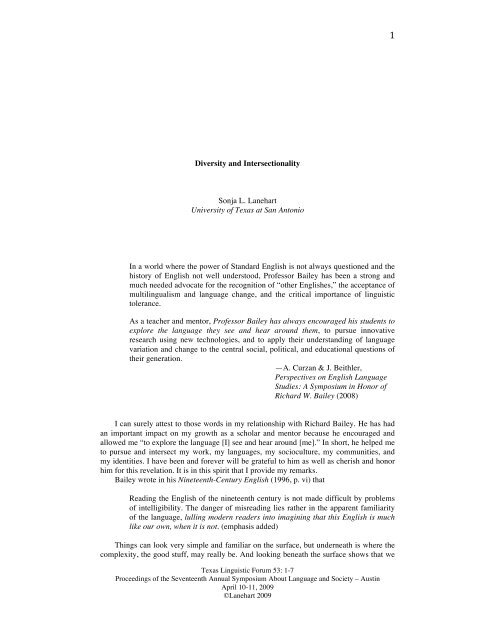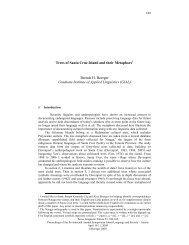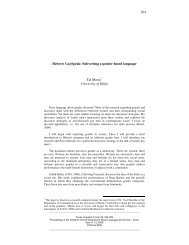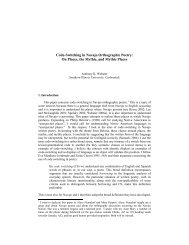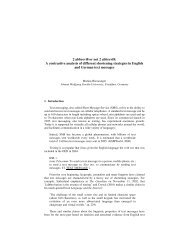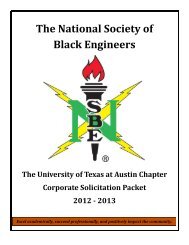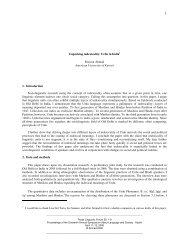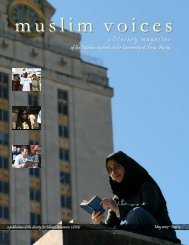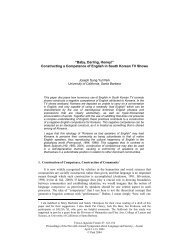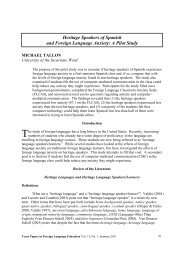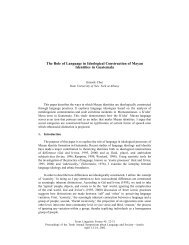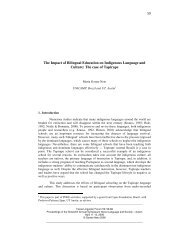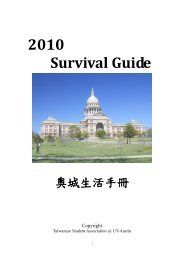Diversity and Intersectionality Sonja L. Lanehart University of Texas ...
Diversity and Intersectionality Sonja L. Lanehart University of Texas ...
Diversity and Intersectionality Sonja L. Lanehart University of Texas ...
Create successful ePaper yourself
Turn your PDF publications into a flip-book with our unique Google optimized e-Paper software.
<br />
<br />
<strong>Diversity</strong> <strong>and</strong> <strong>Intersectionality</strong><br />
<strong>Sonja</strong> L. <strong>Lanehart</strong><br />
<strong>University</strong> <strong>of</strong> <strong>Texas</strong> at San Antonio<br />
In a world where the power <strong>of</strong> St<strong>and</strong>ard English is not always questioned <strong>and</strong> the<br />
history <strong>of</strong> English not well understood, Pr<strong>of</strong>essor Bailey has been a strong <strong>and</strong><br />
much needed advocate for the recognition <strong>of</strong> “other Englishes,” the acceptance <strong>of</strong><br />
multilingualism <strong>and</strong> language change, <strong>and</strong> the critical importance <strong>of</strong> linguistic<br />
tolerance.<br />
As a teacher <strong>and</strong> mentor, Pr<strong>of</strong>essor Bailey has always encouraged his students to<br />
explore the language they see <strong>and</strong> hear around them, to pursue innovative<br />
research using new technologies, <strong>and</strong> to apply their underst<strong>and</strong>ing <strong>of</strong> language<br />
variation <strong>and</strong> change to the central social, political, <strong>and</strong> educational questions <strong>of</strong><br />
their generation.<br />
—A. Curzan & J. Beithler,<br />
Perspectives on English Language<br />
Studies: A Symposium in Honor <strong>of</strong><br />
Richard W. Bailey (2008)<br />
I can surely attest to those words in my relationship with Richard Bailey. He has had<br />
an important impact on my growth as a scholar <strong>and</strong> mentor because he encouraged <strong>and</strong><br />
allowed me “to explore the language [I] see <strong>and</strong> hear around [me].” In short, he helped me<br />
to pursue <strong>and</strong> intersect my work, my languages, my socioculture, my communities, <strong>and</strong><br />
my identities. I have been <strong>and</strong> forever will be grateful to him as well as cherish <strong>and</strong> honor<br />
him for this revelation. It is in this spirit that I provide my remarks.<br />
Bailey wrote in his Nineteenth-Century English (1996, p. vi) that<br />
Reading the English <strong>of</strong> the nineteenth century is not made difficult by problems<br />
<strong>of</strong> intelligibility. The danger <strong>of</strong> misreading lies rather in the apparent familiarity<br />
<strong>of</strong> the language, lulling modern readers into imagining that this English is much<br />
like our own, when it is not. (emphasis added)<br />
Things can look very simple <strong>and</strong> familiar on the surface, but underneath is where the<br />
complexity, the good stuff, may really be. And looking beneath the surface shows that we<br />
<strong>Texas</strong> Linguistic Forum 53: 1-7<br />
Proceedings <strong>of</strong> the Seventeenth Annual Symposium About Language <strong>and</strong> Society – Austin<br />
April 10-11, 2009<br />
©<strong>Lanehart</strong> 2009<br />
1
<br />
are more than the sum <strong>of</strong> our parts. We no longer live in a closed, protectionist society; we<br />
are part <strong>of</strong> a global village. Given the Internet, I do not know that it is even six degrees <strong>of</strong><br />
separation anymore; I think it is more like two or three. In any event, the traditional belief<br />
that we are all very easily categorized is passé. We are in the age <strong>of</strong> post-modernity, neo-<br />
Marxism, critical race theory, <strong>and</strong> LatCrit. While scholars are currently preparing people<br />
for jobs that will no longer exist, they need to prepare them for jobs that do not yet exist as<br />
well as ways <strong>of</strong> doing <strong>and</strong> being that have not been imagined. Many English Language<br />
Studies scholars (ELS) <strong>and</strong> sociolinguists seem not to have gotten the memo. While we<br />
would like to continue believing <strong>and</strong> acting as if our old dichotomies <strong>of</strong> White language-<br />
Black language, women’s language-men’s language, rural language-urban language, <strong>and</strong><br />
St<strong>and</strong>ard language-nonst<strong>and</strong>ard language continue to describe <strong>and</strong> define with whom we<br />
do our work <strong>and</strong> where “the” answers are, such traditional categories no longer work<br />
effectively.<br />
Our parts are many—gender, region/locale, nationality, religion, skin color,<br />
phenotype, education/schooling, ability, sexuality, race, ethnicity, age/generation,<br />
socioeconomic class, physiology, language, variety, sex, etc.—but we are more than the<br />
sum <strong>of</strong> them. All that makes us who we are intersects multiplicatively, not additively (see<br />
Figure 1). Just the intersection <strong>of</strong> race, class, <strong>and</strong> gender provides a multitude <strong>of</strong><br />
complexities in examining the implications <strong>and</strong> explanations about language diversity <strong>and</strong><br />
use. ELS <strong>and</strong> Sociolinguistics need to transition into the 21 st century contexts a little<br />
better; hence, my discussion on diversity <strong>and</strong> intersectionality.<br />
1 Here’s the Scoop<br />
The term "<strong>Intersectionality</strong> Theory" gained prominence in the 1990s when sociologist<br />
Patricia Hill Collins (1990) integrated the idea as part <strong>of</strong> her discussion on Black<br />
feminism, or "Black feminist thought", <strong>and</strong> made research about Black women more<br />
complex <strong>and</strong> less connected to mainstream feminist research than had been done<br />
previously. Collins’ work included women <strong>of</strong> color in her theoretical perspective <strong>and</strong><br />
accounted for the exponential salience <strong>and</strong>, hence, intersection, <strong>of</strong> race, gender, class, <strong>and</strong><br />
sexuality .<br />
According to Susanne Knudsen (2006, p. 61), intersectionality is a theory “to analyse<br />
how social <strong>and</strong> cultural categories intertwine. The relationships between gender, race<br />
ethnicity, disability, sexuality, class <strong>and</strong> nationality are examined” on multiple levels to<br />
explicate various inequalities that exist in society. They are not independent <strong>of</strong> one another<br />
but instead are interrelated forms <strong>of</strong> oppression that are manifested in multiple forms <strong>of</strong><br />
discrimination.” While current feminist thought <strong>of</strong> the time reflected the lives <strong>of</strong> middleclass<br />
White women, intersectionality accounted for the complexity <strong>of</strong> women <strong>of</strong> color <strong>and</strong><br />
how the various facets <strong>of</strong> their lives were <strong>of</strong>ten disconnected from White middle-class<br />
women, women <strong>of</strong> color, for example, were less concerned about working outside the<br />
home than actually having a choice to not work outside <strong>of</strong> the home. While racism, <strong>and</strong><br />
sexism were everyday parts <strong>of</strong> the lives <strong>of</strong> women <strong>of</strong> color, they were also up against<br />
classism by what were supposed to be their allies: White women. As is <strong>of</strong>ten the case for<br />
Black women, they are overlooked in research because they are neither White women nor<br />
Black men—two groups they are <strong>of</strong>ten treated as being on the fringe <strong>of</strong>, with respect to<br />
gender <strong>and</strong> race respectively.<br />
<br />
<strong>Texas</strong> Linguistic Forum 53: 1-7<br />
Proceedings <strong>of</strong> the Seventeenth Annual Symposium About Language <strong>and</strong> Society – Austin<br />
April 10-11, 2009<br />
©<strong>Lanehart</strong> 2009<br />
2
<br />
Figure 1. <strong>Diversity</strong> <strong>and</strong> <strong>Intersectionality</strong><br />
While the theory began as an exploration <strong>of</strong> the oppression <strong>of</strong> women within society,<br />
today sociologists strive to apply it not only to women, but also to discussions <strong>of</strong> all<br />
peoples. Knowing that Black people live in a racist society is insufficient for describing<br />
their experiences. It is also necessary to know their ethnicity, gender, generation, class,<br />
sexual orientation, etc. Likewise, intersectionality holds that hegemonic institutions <strong>and</strong><br />
cultures as well as social semiotics reinforce oppressions, <strong>and</strong> shape them. One must<br />
constantly examine the ways hegemonic institutions <strong>and</strong> structures shape <strong>and</strong> are shaped<br />
by gender, race, ethnicity, religion, sexuality, class, nationality, etc. So, while a Supreme<br />
Court nominee is taken to task for saying that a wise Latina can sometimes come to a<br />
better judgement than a white male, we know that our identities <strong>and</strong> experiences provide<br />
the subjectivities for making us the unique individuals we are but they also affect all <strong>of</strong><br />
us—not just people <strong>of</strong> color. Likewise, intersectionality theory is not simply for the benefit<br />
<strong>of</strong> women but for the benefit <strong>of</strong> society. And though whiteness is seen as the norm in<br />
society <strong>and</strong> subsequently the st<strong>and</strong>ard for all judgements, comparisons, epistemologies,<br />
ontologies, etc., whiteness is not the absence <strong>of</strong> bias—it is the presence <strong>of</strong> particular<br />
biases.<br />
According to Leslie McCall (2005), there are three different approaches to studying<br />
intersectionality.<br />
<br />
(1) Anticategorical Complexity, which argues that social categories are<br />
an arbitrary construction <strong>of</strong> history <strong>and</strong> language <strong>and</strong> that they<br />
contribute little to underst<strong>and</strong>ing the ways in which people<br />
experience society. “For example, the category <strong>of</strong> gender was first<br />
understood as constituted by men <strong>and</strong> women, but questions <strong>of</strong> what<br />
distinguishes a man from a woman—is it biological sex, <strong>and</strong> if so<br />
what is biologically male <strong>and</strong> female?—led to the definition <strong>of</strong><br />
<strong>Texas</strong> Linguistic Forum 53: 1-7<br />
Proceedings <strong>of</strong> the Seventeenth Annual Symposium About Language <strong>and</strong> Society – Austin<br />
April 10-11, 2009<br />
©<strong>Lanehart</strong> 2009<br />
3
<br />
<br />
“new” social groups, new in the sense <strong>of</strong> being named but also<br />
perhaps in the sense <strong>of</strong> being created. There are no longer two<br />
genders but countless ones, no longer two sexes but five (Fausto-<br />
Sterling, 2000). Other examples abound. In a remarkably short period<br />
<strong>of</strong> time, bisexual, transgendered, queer, <strong>and</strong> questioning individuals<br />
have been added to the original divide between gay <strong>and</strong> straight<br />
sexuality groups, <strong>and</strong> the social groups that constitute the category <strong>of</strong><br />
race are widely believed to be fundamentally indefinable because <strong>of</strong><br />
multiracialism (see, e.g., Fuss, 1991; Omi & Winant, 1994). And,<br />
theoretically, eventually all groups will be challenged <strong>and</strong> fractured<br />
in turn. As these examples make clear, this approach has been<br />
enormously effective in challenging the singularity, separateness, <strong>and</strong><br />
wholeness <strong>of</strong> a wide range <strong>of</strong> social categories” (McCall, 2005, pp.<br />
1778).<br />
(2) Intercategorical, or Categorical, Complexity, which, “begins with<br />
the observation that there are relationships <strong>of</strong> inequality among<br />
already constituted social groups, as imperfect <strong>and</strong> ever changing as<br />
they are, <strong>and</strong> takes those relationships as the center <strong>of</strong> analysis. The<br />
main task <strong>of</strong> the categorical approach is to explicate those<br />
relationships, <strong>and</strong> doing so requires the provisional use <strong>of</strong> categories.<br />
…. The concern is with the nature <strong>of</strong> the relationships among social<br />
groups <strong>and</strong>, importantly, how they are changing, rather than with the<br />
definition or representation <strong>of</strong> such groups per se. Finally, the type <strong>of</strong><br />
categorical approach I am developing …. leaves open the possibility<br />
that broad social groupings more or less reflect the empirical realities<br />
<strong>of</strong> more detailed social groupings, thus minimizing the extent <strong>of</strong><br />
complexity. … The categorical approach focuses on the complexity<br />
<strong>of</strong> relationships among multiple social groups within <strong>and</strong> across<br />
analytical categories <strong>and</strong> not on complexities within single social<br />
groups, single categories, or both. The subject is multigroup, <strong>and</strong> the<br />
method is systematically comparative” (McCall, 2005, p. 1785).<br />
(3) Intracategorical Complexity, which, “begins with a unified<br />
intersectional core—a single social group, event, or concept—<strong>and</strong><br />
works its way outward to analytically unravel one by one the<br />
influences <strong>of</strong> gender, race, class, <strong>and</strong> so on” (McCall, 2005, p. 1787).<br />
It recognizes the shortcomings <strong>of</strong> existing social categories <strong>and</strong><br />
questions the way they draw boundaries <strong>of</strong> distinction. Hence, this<br />
approach is a cross between the intercategorical <strong>and</strong> categorical<br />
approaches.<br />
According to Knudsen (2006), intersectionality seeks to examine the ways in which<br />
various socially <strong>and</strong> culturally constructed categories interact on multiple levels to<br />
manifest themselves as inequality in society. “<strong>Intersectionality</strong> is used to analyse the<br />
production <strong>of</strong> power <strong>and</strong> processes between gender, race, ethnicity etc., <strong>and</strong> is involved<br />
with analysing social <strong>and</strong> cultural hierarchies within different discourses <strong>and</strong> institutions.<br />
… The theory <strong>of</strong> intersectionality stresses complexity. However, not all categories are<br />
necessarily mentioned” (Knudsen, 2006, pp. 62-63).<br />
<strong>Texas</strong> Linguistic Forum 53: 1-7<br />
Proceedings <strong>of</strong> the Seventeenth Annual Symposium About Language <strong>and</strong> Society – Austin<br />
April 10-11, 2009<br />
©<strong>Lanehart</strong> 2009<br />
4
<br />
According to Crenshaw (1991, p. 1244), there are three ways <strong>of</strong> conceptualizing<br />
interesectionality: structural, political, <strong>and</strong> representational. Structural intersectionality<br />
proposes that strategies based solely on the experiences <strong>of</strong> women who do not share the<br />
same class or race backgrounds will be <strong>of</strong> limited help to women who because <strong>of</strong> race <strong>and</strong><br />
class face different obstacles (Crenshaw, 1991, p. 1246). This was <strong>and</strong> is a divide that<br />
exists within the feminist movement <strong>and</strong> that led women <strong>of</strong> color groups to emerge as<br />
separate from white women’s groups: Black women, Latinas, etc. have many struggles in<br />
common with white women, but they also have many more struggles not in common<br />
because we live in not only a sexist society but also a racist <strong>and</strong> classist one. Hence, the<br />
feminist movement is not big enough, not inclusive enough for women <strong>of</strong> color. As<br />
Crenshaw (1991, p. 1250) asserts, women <strong>of</strong> color occupy positions both physically <strong>and</strong><br />
culturally marginalized within dominant society, <strong>and</strong> so methods must be targeted directly<br />
to them in order to reach them.<br />
According to Crenshaw (1991, p. 1252), political intersectionality proposes that<br />
women <strong>of</strong> color are situated within at least two subordinated groups that frequently pursue<br />
conflicting political agendas. The need to split one's political energies between two,<br />
sometimes opposing, groups is a dimension <strong>of</strong> intersectional disempowerment that men <strong>of</strong><br />
color <strong>and</strong> white women seldom confront. Because women <strong>of</strong> color experience racism in<br />
ways not always the same as those experienced by men <strong>of</strong> color <strong>and</strong> sexism in ways not<br />
always parallel to experiences <strong>of</strong> white women, antiracism <strong>and</strong> feminism are limited, even<br />
on their own terms. Sexual stratification theory posits that women are stratified sexually<br />
by race. In traditional sociolinguistic studies on African American Language, Black men<br />
have been more favored in research than Black women because, for some, they have been<br />
seen as the true arbiters <strong>of</strong> African American Language. Only more recent research has<br />
focused on Black women (e.g., Jacobs-Huey, 2006; <strong>Lanehart</strong>, 2002, 2009; Troutman,<br />
2001; Morgan, 1991, 1996, 1999, 2002). This seems unconscionable given that men <strong>and</strong><br />
women are Black <strong>and</strong> both use language. To negate the existence <strong>and</strong> experience <strong>of</strong> one or<br />
to subordinate it is contrary to the goals <strong>of</strong> sociolinguistics <strong>and</strong> ELS.<br />
The failure <strong>of</strong> feminism to interrogate race means that the resistance strategies <strong>of</strong><br />
feminism will <strong>of</strong>ten replicate <strong>and</strong> reinforce the subordination <strong>of</strong> people <strong>of</strong> color, <strong>and</strong> the<br />
failure <strong>of</strong> antiracism to interrogate patriarchy means that antiracism will frequently<br />
reproduce the subordination <strong>of</strong> women (Crenshaw, 1991, p. 1252). Likewise, race-based<br />
priorities function to obscure the issues <strong>of</strong> women <strong>of</strong> color; feminist concerns <strong>of</strong>ten<br />
suppress minority experiences as well.<br />
According to Crenshaw (1991, p. 1283), representational intersectionality purports<br />
that race <strong>and</strong> gender converge so that the concerns <strong>of</strong> minority women fall into the void<br />
between concerns about women's issues <strong>and</strong> concerns about racism. Debates over<br />
representation continually elide the intersection <strong>of</strong> race <strong>and</strong> gender in the popular culture’s<br />
construction <strong>of</strong> images <strong>of</strong> women <strong>of</strong> color. Accordingly, an analysis <strong>of</strong> what may be<br />
termed "representational intersectionality" would include both the ways in which these<br />
images are produced through a confluence <strong>of</strong> prevalent narratives <strong>of</strong> race <strong>and</strong> gender, as<br />
well as a recognition <strong>of</strong> how contemporary critiques <strong>of</strong> racist <strong>and</strong> sexist representation<br />
marginalize women <strong>of</strong> color (Crenshaw, 1991, p. 1283).<br />
In summary, an intersectional analysis argues that: (1) racial <strong>and</strong> sexual subordination<br />
are mutually reinforcing; (2) Black women are commonly marginalized by a politics <strong>of</strong><br />
race alone or gender alone; <strong>and</strong> (3) a political response to each form <strong>of</strong> subordination must<br />
at the same time be a political response to both (Crenshaw, 1991, p. 1283).<br />
2 An Example <strong>and</strong> Explanation<br />
<br />
<strong>Texas</strong> Linguistic Forum 53: 1-7<br />
Proceedings <strong>of</strong> the Seventeenth Annual Symposium About Language <strong>and</strong> Society – Austin<br />
April 10-11, 2009<br />
©<strong>Lanehart</strong> 2009<br />
5
<br />
One example <strong>of</strong> the problem <strong>of</strong> intersectionality’s complexity in ELS <strong>and</strong><br />
sociolinguistics can be seen in a problem I encountered while organizing my Spring 2008<br />
African American Women’s Language conference. I wanted a researcher who studied<br />
Black lesbian language. I couldn’t find anyone despite numerous inquiries. This is an<br />
example <strong>of</strong> diversity <strong>and</strong> intersectionality. “Black Lesbian Language” involved more than<br />
one degree beyond “the norm,” if we agree or consider that society views the norm as<br />
White heterosexual male. So, while it is possible to find scholars who study Black male<br />
language or white female language—one degree from the norm—it is more difficult to<br />
find a scholar who studies Black lesbian language or Afro-Latina language. Society views<br />
“the norm” as White heterosexual male; these are more than one degree beyond “the<br />
norm”: Black Lesbian Language, Afro-Latina Language, Upperclass Black Language.<br />
That is not to say that there are not people or scholars who are not Black <strong>and</strong> lesbian or<br />
Afro-Latina, but it is that the complexity <strong>of</strong> that representation is unfamiliar for ELS <strong>and</strong><br />
sociolinguistics. As indicated by Carmen Fought at NWAV 37 (Fought, 2008), ELS <strong>and</strong><br />
sociolinguistics still have trouble dealing with data <strong>and</strong> as William Kretzschmar (in press)<br />
has indicated, ELS <strong>and</strong> sociolinguistics are grappling with issues <strong>of</strong> scale even if they have<br />
not consciously recognized such.<br />
Another explanation might be that we do not have enough Richard Baileys preparing<br />
<strong>and</strong> mentoring future scholars in ELS <strong>and</strong> sociolinguistics that encourage <strong>and</strong> insist in<br />
some cases that students or faculty explore the language they see <strong>and</strong> hear around them<br />
(Bailey, 2008) <strong>and</strong> the very language that actually exists <strong>and</strong> that they participate in. We<br />
need to move from the seemingly familiar to the possibly unfamiliar <strong>and</strong> underst<strong>and</strong> that<br />
things are not always as they were—or appear to be.<br />
3 Conclusions <strong>and</strong> Better Research Directions<br />
<strong>Intersectionality</strong> might be more broadly useful as a way <strong>of</strong> mediating the tension<br />
between assertions <strong>of</strong> multiple identity <strong>and</strong> the ongoing necessity <strong>of</strong> group politics.<br />
Although we are more than the sum <strong>of</strong> our parts, each part has a say in our identity.<br />
According to Tabouret-Keller (1997, p. 323), individuals’ ability to get into focus with<br />
whom they wish to identify is constrained: One can only behave according to the<br />
behavorial patterns <strong>of</strong> groups one finds it desirable to identify with to the extent that:<br />
<br />
1. One can identify the groups;<br />
2. One has both adequate access to the groups <strong>and</strong> ability to analyze their<br />
behavioral patterns;<br />
3. The motivation for joining the group is sufficiently powerful, <strong>and</strong> is either<br />
reinforced or lessened by feedback from the group;<br />
4. We have the ability to modify our behavior.<br />
As such, according to Tabouret-Keller (1997, 323-24), language, however defined,<br />
precedes any <strong>of</strong> us at birth <strong>and</strong> the existential locus <strong>of</strong> Homo sapiens, be it individuals or<br />
groups, is in language itself. <strong>Intersectionality</strong> provides a basis for reconceptualizing X or<br />
Y or Z (e.g., race, sexuality, ability, class, gender, etc.) as a coalition between X/Y or<br />
X/Y/Z (e.g., race <strong>and</strong> sexuality, sexuality <strong>and</strong> ability, race <strong>and</strong> gender, race <strong>and</strong> class <strong>and</strong><br />
gender, etc.). We can now dare to speak against internal exclusions <strong>and</strong> marginalizations,<br />
so that we might call attention to how the identity <strong>of</strong> “the group” has been centered on the<br />
intersectional identities <strong>of</strong> a few. Also, we recognize that identity politics take place at the<br />
site where categories intersect, thus seeming more fruitful than challenging the possibility<br />
<strong>of</strong> talking about categories at all.<br />
<strong>Texas</strong> Linguistic Forum 53: 1-7<br />
Proceedings <strong>of</strong> the Seventeenth Annual Symposium About Language <strong>and</strong> Society – Austin<br />
April 10-11, 2009<br />
©<strong>Lanehart</strong> 2009<br />
6
<br />
Better research directions might be that we (1) Explore the language we see <strong>and</strong> hear<br />
around us <strong>and</strong> the very language that actually exists <strong>and</strong> that we participate in; (2) step<br />
outside the box <strong>of</strong> “the norm” to the human condition box; <strong>and</strong> (3) articulate speaker<br />
characteristics <strong>and</strong> acknowledge their significance to the identity <strong>and</strong> language production<br />
<strong>and</strong> use <strong>of</strong> speakers.<br />
<br />
References<br />
Bailey, R.W. (1996). Nineteenth-century English. Ann Arbor: <strong>University</strong> <strong>of</strong> Michigan<br />
Press.<br />
Collins, Patricia Hill. (1990). Black feminist thought: Knowledge, consciousness, <strong>and</strong> the<br />
politics <strong>of</strong> empowerment. New York: Routledge.<br />
Crenshaw, K. (1991). Mapping the margins: <strong>Intersectionality</strong>, identity politics, <strong>and</strong><br />
violence against women <strong>of</strong> color. Stanford Law Review, 1241-1299.<br />
Curzan, A. & J. Beithler. (2008). Perspectives on English Language Studies: A Symposium<br />
in Honor <strong>of</strong> Richard W. Bailey.<br />
.<br />
Fausto-Sterling, A. (2000). Sexing the body: Gender politics <strong>and</strong> the construction <strong>of</strong><br />
sexuality. New York: Basic Books.<br />
Fought, C. (2008). On the borderl<strong>and</strong>s <strong>of</strong> communities: Taking linguistic research to la<br />
frontera. Plenary address, NWAV 37, Houston, TX, November 6-9.<br />
Fuss, D. (Ed.). (1991). Inside/out: Lesbian theories, gay theories. New York: Routledge.<br />
Jacobs-Huey, L. (2006). From the kitchen to the parlor: Language <strong>and</strong> African American<br />
women’s hair care. Oxford: Oxford <strong>University</strong> Press.<br />
Knudsen, S. (2006). <strong>Intersectionality</strong>: A theoretical inspiration in the analysis <strong>of</strong> minority<br />
cultures <strong>and</strong> identities in textbooks. Caught in the web or lost in the textbook, 61-76. 5<br />
December 2008.
<br />
Morgan, M. (1999). “'No woman no cry”: Claiming African American women's place. In<br />
M. Bucholtz, A. C. Liang, & L. A. Sutton (Eds.), Reinventing identities: Category to<br />
practice in language <strong>and</strong> gender (pp. 27-45). Oxford: Oxford <strong>University</strong> Press.<br />
Omi, M., & Winant, H. (1994). Racial formation in the United States: From the 1960s to<br />
the 1990s. New York: Routledge.<br />
Tabouret-Keller, A. (1997). Language <strong>and</strong> identity. In F. Coulmas (Ed.), The H<strong>and</strong>book <strong>of</strong><br />
Sociolinguistics (pp. 315-326). Oxford: Blackwell Publishers.<br />
Troutman, D. (2001). African American women: Talking that talk. In S. L. <strong>Lanehart</strong> (Ed.),<br />
Sociocultural <strong>and</strong> historical contexts <strong>of</strong> African American English (pp. 211-237).<br />
Amsterdam & Philadelphia: John Benjamins.<br />
<strong>Sonja</strong> L. <strong>Lanehart</strong><br />
Department <strong>of</strong> English<br />
<strong>University</strong> <strong>of</strong> <strong>Texas</strong> at San Antonio<br />
1 UTSA Circle<br />
San Antonio, TX 78249-0643<br />
USA<br />
<strong>Sonja</strong>.<strong>Lanehart</strong>@utsa.edu<br />
<br />
<strong>Texas</strong> Linguistic Forum 53: 1-7<br />
Proceedings <strong>of</strong> the Seventeenth Annual Symposium About Language <strong>and</strong> Society – Austin<br />
April 10-11, 2009<br />
©<strong>Lanehart</strong> 2009<br />
8


